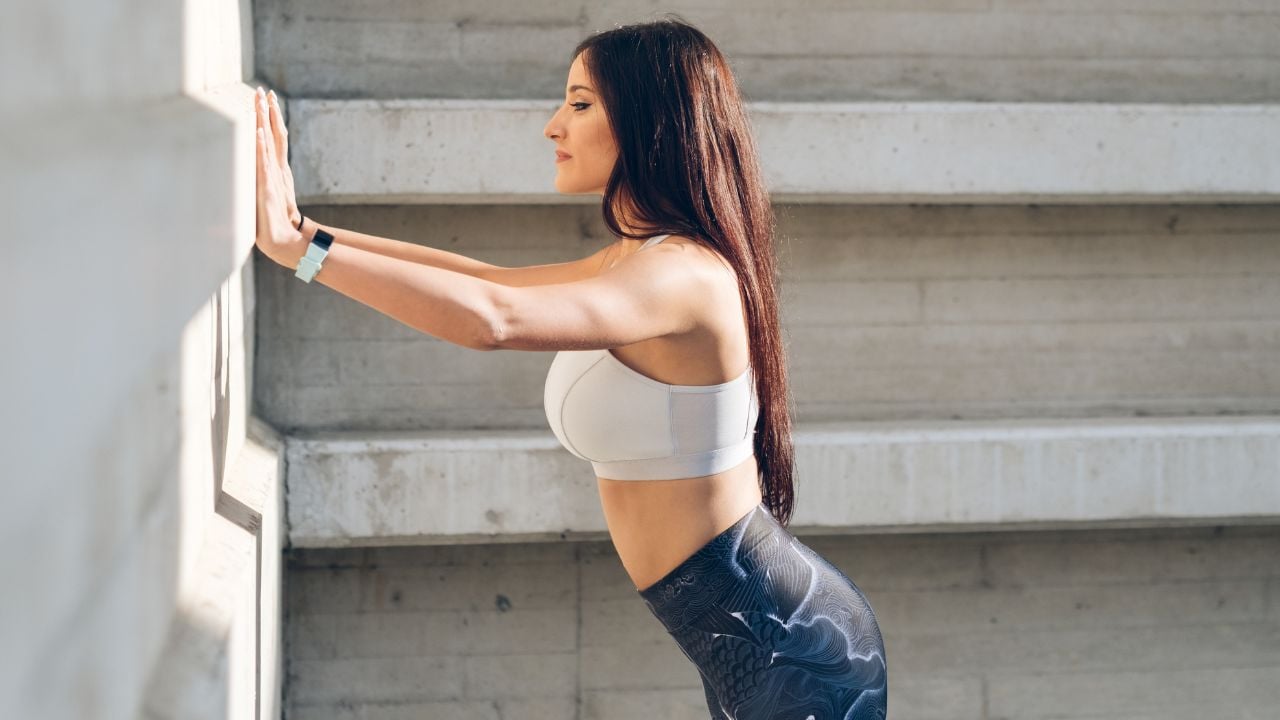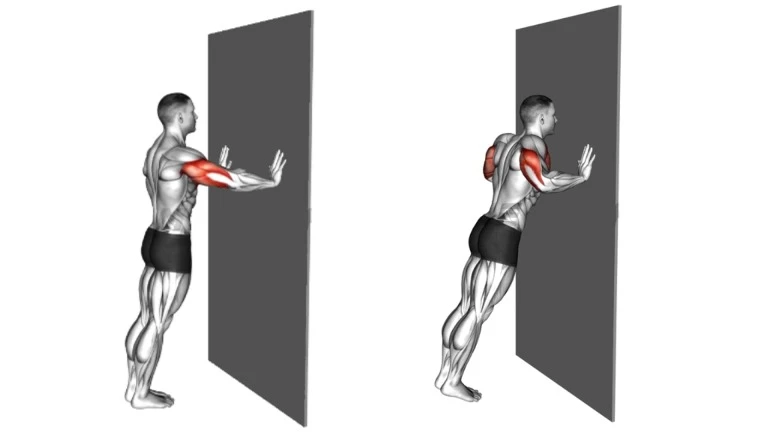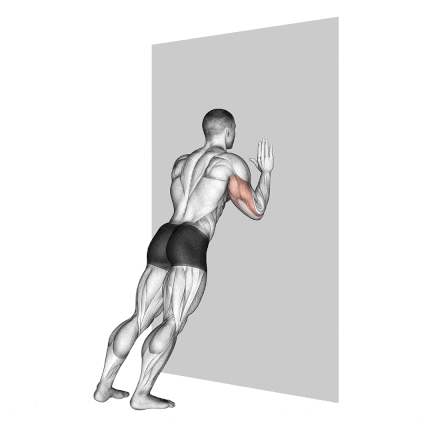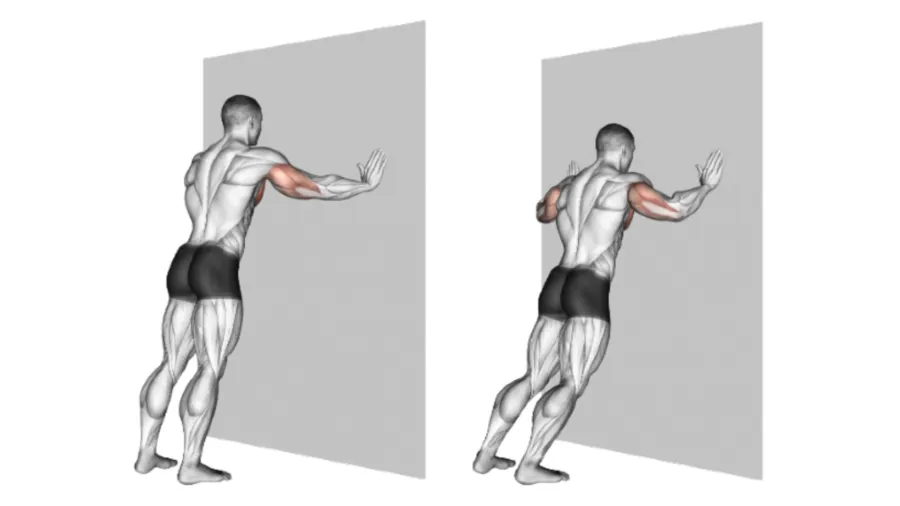A wall push-up is a great, gentle modified version of traditional push-ups that can help strengthen your chest, shoulders, and triceps.
It is a beginner-friendly exercise that helps build upper body strength, improve core stability, and enhance posture.
Instead of doing push-ups on the floor, you lean against a wall. This vertical orientation reduces the load caused by gravity.
The inclined position of wall push-ups creates a mechanical advantage by reducing the percentage of body weight being moved. In a traditional floor push-up, approximately 60-70% of body weight is supported by the arms, whereas wall push-ups typically require supporting only 20-30% of body weight, depending on the angle to the wall.
Wall push-ups are ideal for those who need a gentler approach because:
- They place less stress on the shoulder joints
- They reduce pressure on wrist joints compared to traditional push-ups
- They can be done anytime, anywhere, if you have a wall to push against.

- Wall Push-Ups Muscles Worked
- How To Do Wall Push-Up
- Tips for Proper Form
- Wall Push-Ups Progression and Variations
- 1. Close-Grip Wall Push-Up
- 2. Wide Grip Wall Up
- 3. Plyometric Wall Push Up
- 4. One-Armed Wall Push Up
- FAQs
- Are wall push-ups effective?
- How many wall push-ups equal 1 push-up?
- What will happen if I do 100 Wall pushups a day?
- How Many calories are burned during a wall push?
- How Many Wall Push-Ups Should I Do A Day
- Reference
Wall Push-Ups Muscles Worked
Wall pushups are a full-body workout, they also work many muscles to keep the position and movement stable.
- Primary Muscles (Major Movers): Pectoralis major (chest muscles), Anterior deltoids (front shoulders) and Triceps brachii
- Secondary (Assisting Muscles): Serratus anterior, Posterior deltoids (rear shoulders)
- Stabilizing Muscles: Core muscles (rectus abdominis, transverse abdominis, obliques), Rotator cuff muscles, Rhomboids and trapezius and Erector spinae (lower back)

How To Do Wall Push-Up
- Before you do wall push-ups, you need to find the right wall space.
- Place your hands on the wall slightly wider than shoulder-width apart.
- Align your hands with your mid-chest (not too high, not too low).
- Fingers can point upwards or slightly outwards – comfort is key. Spread your fingers wide for a better base.
- Engage your core. Imagine drawing your belly button towards your spine.
- Create a straight line from your head, through your shoulders, hips, knees, and down to your ankles. Avoid arching your back or letting your hips sag.
- Slowly bend your elbows, allowing your chest and head to move towards the wall.
- As you lower, let your shoulder blades gently squeeze together (retract). This is a subtle but important movement for shoulder health.
- Keep your elbows from flaring out excessively. Aim for a 45-60 degree angle relative to your torso (think arrow shape, not a “T” shape).
- Push your body back up to the starting position, straightening your arms.
- Repeat for the desired number of reps.
Tips for Proper Form
- Consciously brace your abs like you’re about to be punched. Squeeze your glutes. Re-establish that straight line from head to heels.
- Most people should be approximately an arm’s length away from the wall’s surface—not too close or too far.
- Keep your head in line with your spine. Avoid looking up at the ceiling, down at your feet, or jutting your chin forward. Pick a spot on the wall slightly in front of you and keep your gaze there.
- Do not flare your elbows out 90°, as this puts excessive strain on the shoulder. A slight tuck (about 30–45°) is safer and more effective.
- As you push away from the wall, allow your shoulder blades to protract (spread apart) slightly. At the bottom, gently retract the shoulder blades together. This scapular motion keeps your shoulder girdle stable.
- Don’t stop too early or lock out elbows sharply. Lower until your chest or nose nearly touches the wall and fully extend elbows on the way up.
- Inhale deeply as you lean in (lower your body) and exhale as you push back up. Do not hold your breath. Proper breathing supports core stability and performance.
Wall Push-Ups Progression and Variations
As you get stronger, wall push-ups can be made more challenging or serve as a stepping-stone to harder push-up types:
- The simplest progression is to move your feet farther from the wall. This increases the lean angle, so you lift more of your body weight. The farther your feet, the harder each rep.
- Bring your hands closer together (diamond or close-grip) on the wall. This shifts emphasis to the triceps and inner chest.
- Do the wall push-up with a single arm. This unilateral version dramatically increases difficulty and core demand. Switch arms for balanced strength.
1. Close-Grip Wall Push-Up
When you bring your hands closer together during wall push-ups, you fundamentally change the movement pattern, shifting more of the workload to your triceps.
This happens because the closer hand position reduces the contribution from the chest muscles while increasing the elbow extension demands (triceps).
When performing close-grip wall push-ups, your elbows naturally stay closer to your body rather than flaring out to the sides. This position—sometimes called a “tucked” position—reduces rotational forces on the shoulder joint.
They’re a good choice for those looking to increase upper chest and tricep size.

2. Wide Grip Wall Up
A wide grip is often chosen if the goal is to minimise triceps work and maximise chest focus (specifically the outer chest).
Wide grip wall push-ups are more challenging than standard standing push-ups, which emphasise the chest muscles more.
Widening your grip increases horizontal abduction of the shoulder joint, meaning your pectoralis major (chest muscle) has to contract harder to bring your arms inward during the push.
The anterior deltoids and serratus anterior get more involved in scapular stabilisation.

3. Plyometric Wall Push Up
Plyometric wall push-ups, or clapping push-ups, are a type of plyometric exercise. During this exercise, you push off the wall hard enough to lift your hands off the wall and clap before returning to where you started.
Plyometric Wall Push-Ups are an excellent beginner-to-intermediate-level power-building variation of the classic wall push-up.
Explosive movements are metabolically taxing. While a single set might be short, the intensity can lead to a higher calorie burn during and after the workout (EPOC – Excess Post-exercise Oxygen Consumption).
4. One-Armed Wall Push Up
The One-Armed Wall Push-Up is an excellent progression if you’re ready to seriously challenge your unilateral (single-sided) strength, core stability, and anti-rotational capabilities.
A single arm now bears the entire load of the upper body portion. This forces the pectoralis major, anterior deltoid, and triceps of the working side to work much harder than in a two-armed version.
With only one point of contact on the wall, your body naturally wants to rotate away from the working arm. Your obliques, transverse abdominis, quadratus lumborum, and even glutes must work incredibly hard isometrically to resist this rotation and keep your torso square to the wall.
FAQs
Are wall push-ups effective?
Yes, wall push-ups can strengthen your upper body muscles, including your chest, triceps, and shoulders.
They are low-impact exercises suitable for people of all fitness levels. They’re a good choice for people who are new to strength training.
To get the most out of wall push-ups, keep the right form and do them hard enough to push your muscles.
How many wall push-ups equal 1 push-up?
It’s difficult to say exactly how many wall push-ups are equivalent to one standard push-up, as it depends on the individual’s strength and fitness level.
Doing 2 to3 wall push-ups is about the same as doing 1 regular push-up.
However, wall push-ups are easier than standard push-ups because they place less stress on the muscles and joints.
To compare the difficulty of wall push-ups to standard push-ups, try doing both exercises and see how many reps you can do of each.
You may find that you can do more wall push-ups than standard push-ups or only a few reps of each before feeling fatigued.
What will happen if I do 100 Wall pushups a day?
Doing 100 wall push-ups daily could be a good way to strengthen your upper body, including your chest, triceps, and shoulders.
However, it’s important to remember that every person is different, and the number of push-ups you can do will depend on your current strength and fitness level.
If you’re starting out with wall push-ups, it’s important to build up gradually to avoid overloading your muscles and risking injury.
You can start by doing a few sets of wall push-ups with a short rest in between, and gradually increase the number of reps and sets as you get stronger.
How Many calories are burned during a wall push?
The number of calories burned during wall push-ups depends on various factors, including weight, age, and intensity level. Here are a few estimates based on a general calorie calculator:
- A person weighing 125 lbs (57 kg) can expect to burn around 70 calories in 30 minutes.
- A person weighing 155 lbs (70 kg) can expect to burn around 87 calories in 30 minutes.
- A person weighing 185 lbs (84 kg) can expect to burn around 105 calories in 30 minutes.
How Many Wall Push-Ups Should I Do A Day
As a beginner, you can start with 10–15 reps per set and do 3–4 sets. Then, gradually increase the number of reps and sets as you strengthen.
As you become more comfortable and stronger, you can do 2–4 sets of 20-40 wall push-ups.
Many people have tried doing 100 wall push-ups daily for a month and seen improvements in their push-up form and upper body strength.
Reference
- Castelein B, Cagnie B, Parlevliet T, Cools A. Serratus anterior or pectoralis minor: Which muscle has the upper hand during protraction exercises? Man Ther. 2016 Apr;22:158-64. doi: 10.1016/j.math.2015.12.002. Epub 2015 Dec 22. PMID: 26749459.
- Marcolin G, Petrone N, Moro T, Battaglia G, Bianco A, Paoli A. Selective Activation of Shoulder, Trunk, and Arm Muscles: A Comparative Analysis of Different Push-Up Variants. J Athl Train. 2015 Nov;50(11):1126-32. doi: 10.4085/1062-6050-50.9.09. Epub 2015 Oct 21. PMID: 26488636; PMCID: PMC4732391.

Manish is a NASM-certified fitness and nutrition coach with over 10 years of experience in weight lifting and fat loss fitness coaching. He specializes in gym-based training and has a lot of knowledge about exercise, lifting technique, biomechanics, and more.
Through “Fit Life Regime,” he generously shares the insights he’s gained over a decade in the field. His goal is to equip others with the knowledge to start their own fitness journey.
